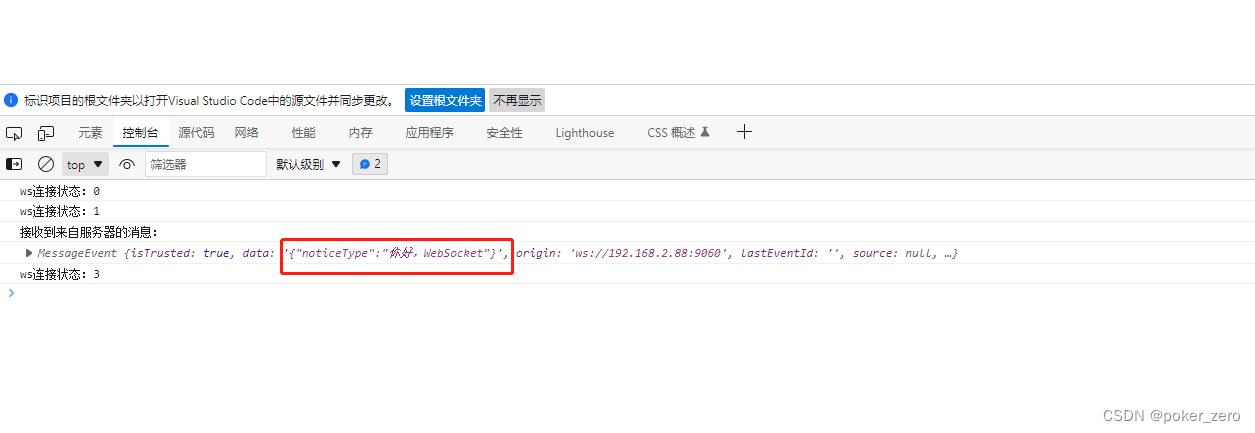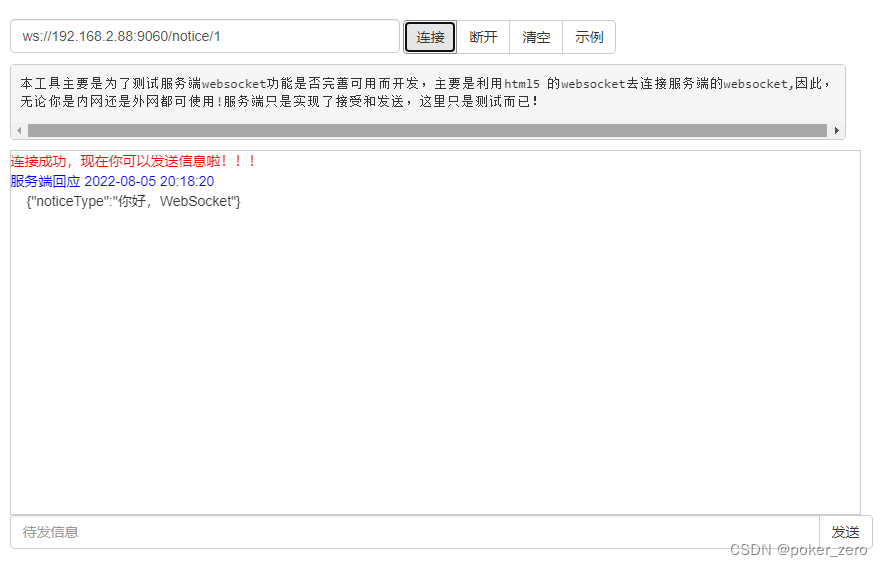java后端+前端使用WebSocket实现消息推送(流程+详细代码)
在项目的开发时,遇到实现服务器主动发送数据到前端页面的功能的需求。实现该功能不外乎使用轮询和websocket技术,但在考虑到实时性和资源损耗后,最后决定使用websocket。现在就记录一下用Java实现Websocket技术吧~
Java实现Websocket通常有两种方式:1、创建WebSocketServer类,里面包含open、close、message、error等方法;2、利用Springboot提供的webSocketHandler类,创建其子类并重写方法。我们项目虽然使用Springboot框架,不过仍采用了第一种方法实现。
创建WebSocket的简单实例操作流程
1.引入Websocket依赖
<!-- https://mvnrepository.com/artifact/org.springframework.boot/spring-boot-starter-websocket --><dependency><groupId>org.springframework.boot</groupId><artifactId>spring-boot-starter-websocket</artifactId><version>2.7.0</version></dependency>
2.创建配置类WebSocketConfig
importorg.springframework.context.annotation.Bean;importorg.springframework.context.annotation.Configuration;importorg.springframework.web.socket.server.standard.ServerEndpointExporter;/**
* 开启WebSocket支持
*/@ConfigurationpublicclassWebSocketConfig{@BeanpublicServerEndpointExporterserverEndpointExporter(){returnnewServerEndpointExporter();}}
3.创建WebSocketServer
在websocket协议下,后端服务器相当于ws里面的客户端,需要用@ServerEndpoint指定访问路径,并使用@Component注入容器
@ServerEndpoint:当ServerEndpointExporter类通过Spring配置进行声明并被使用,它将会去扫描带有@ServerEndpoint注解的类。被注解的类将被注册成为一个WebSocket端点。所有的配置项都在这个注解的属性中
( 如:@ServerEndpoint(“/ws”) )
下面的栗子中@ServerEndpoint指定访问路径中包含sid,这个是用于区分每个页面
importcom.alibaba.fastjson.JSONObject;importlombok.extern.slf4j.Slf4j;importorg.springframework.stereotype.Component;importorg.springframework.util.StringUtils;importjavax.websocket.*;importjavax.websocket.server.PathParam;importjavax.websocket.server.ServerEndpoint;importjava.io.IOException;importjava.net.Socket;importjava.util.*;importjava.util.concurrent.ConcurrentHashMap;/**
* @ServerEndpoint 注解是一个类层次的注解,它的功能主要是将目前的类定义成一个websocket服务器端,
* 注解的值将被用于监听用户连接的终端访问URL地址,客户端可以通过这个URL来连接到WebSocket服务器端
*/@ServerEndpoint("/notice/{userId}")@Component@Slf4jpublicclassNoticeWebsocket{//记录连接的客户端publicstaticMap<String,Session> clients =newConcurrentHashMap<>();/**
* userId关联sid(解决同一用户id,在多个web端连接的问题)
*/publicstaticMap<String,Set<String>> conns =newConcurrentHashMap<>();privateString sid =null;privateString userId;/**
* 连接成功后调用的方法
* @param session
* @param userId
*/@OnOpenpublicvoidonOpen(Session session,@PathParam("userId")String userId){this.sid = UUID.randomUUID().toString();this.userId = userId;
clients.put(this.sid, session);Set<String> clientSet = conns.get(userId);if(clientSet==null){
clientSet =newHashSet<>();
conns.put(userId,clientSet);}
clientSet.add(this.sid);
log.info(this.sid +"连接开启!");}/**
* 连接关闭调用的方法
*/@OnClosepublicvoidonClose(){
log.info(this.sid +"连接断开!");
clients.remove(this.sid);}/**
* 判断是否连接的方法
* @return
*/publicstaticbooleanisServerClose(){if(NoticeWebsocket.clients.values().size()==0){
log.info("已断开");returntrue;}else{
log.info("已连接");returnfalse;}}/**
* 发送给所有用户
* @param noticeType
*/publicstaticvoidsendMessage(String noticeType){NoticeWebsocketResp noticeWebsocketResp =newNoticeWebsocketResp();
noticeWebsocketResp.setNoticeType(noticeType);sendMessage(noticeWebsocketResp);}/**
* 发送给所有用户
* @param noticeWebsocketResp
*/publicstaticvoidsendMessage(NoticeWebsocketResp noticeWebsocketResp){String message =JSONObject.toJSONString(noticeWebsocketResp);for(Session session1 :NoticeWebsocket.clients.values()){try{
session1.getBasicRemote().sendText(message);}catch(IOException e){
e.printStackTrace();}}}/**
* 根据用户id发送给某一个用户
* **/publicstaticvoidsendMessageByUserId(String userId,NoticeWebsocketResp noticeWebsocketResp){if(!StringUtils.isEmpty(userId)){String message =JSONObject.toJSONString(noticeWebsocketResp);Set<String> clientSet = conns.get(userId);if(clientSet !=null){Iterator<String> iterator = clientSet.iterator();while(iterator.hasNext()){String sid = iterator.next();Session session = clients.get(sid);if(session !=null){try{
session.getBasicRemote().sendText(message);}catch(IOException e){
e.printStackTrace();}}}}}}/**
* 收到客户端消息后调用的方法
* @param message
* @param session
*/@OnMessagepublicvoidonMessage(String message,Session session){
log.info("收到来自窗口"+this.userId+"的信息:"+message);}/**
* 发生错误时的回调函数
* @param error
*/@OnErrorpublicvoidonError(Throwable error){
log.info("错误");
error.printStackTrace();}}
封装了一个发送消息的对象可以直接使用
importio.swagger.annotations.ApiModel;importio.swagger.annotations.ApiModelProperty;importlombok.Data;@Data@ApiModel("ws通知返回对象")publicclassNoticeWebsocketResp<T>{@ApiModelProperty(value ="通知类型")privateString noticeType;@ApiModelProperty(value ="通知内容")privateT noticeInfo;}
4.websocket调用
一个用户调用接口,主动将信息发给后端,后端接收后再主动推送给指定/全部用户
@RestController@RequestMapping("/order")publicclassOrderController{@GetMapping("/test")publicRtest(){NoticeWebsocket.sendMessage("你好,WebSocket");returnR.ok();}}
前端WebSocket连接
<!DOCTYPEhtml><htmllang="en"><head><metacharset="UTF-8"><title>SseEmitter</title></head><body><divid="message"></div></body><script>var limitConnect =0;init();functioninit(){var ws =newWebSocket('ws://192.168.2.88:9060/notice/1');// 获取连接状态
console.log('ws连接状态:'+ ws.readyState);//监听是否连接成功
ws.onopen=function(){
console.log('ws连接状态:'+ ws.readyState);
limitConnect =0;//连接成功则发送一个数据
ws.send('我们建立连接啦');}// 接听服务器发回的信息并处理展示
ws.onmessage=function(data){
console.log('接收到来自服务器的消息:');
console.log(data);//完成通信后关闭WebSocket连接// ws.close();}// 监听连接关闭事件
ws.onclose=function(){// 监听整个过程中websocket的状态
console.log('ws连接状态:'+ ws.readyState);reconnect();}// 监听并处理error事件
ws.onerror=function(error){
console.log(error);}}functionreconnect(){
limitConnect ++;
console.log("重连第"+ limitConnect +"次");setTimeout(function(){init();},2000);}</script></html>
项目启动,打开页面后控制台打印连接信息
调用order/test方法后前端打印推送消息内容
这样,就可以接口或者ws调用网址的方式进行websocket的通信啦~
如果没有前端页面也可以使用在线WebSocket测试
OK,下课!!!
版权归原作者 poker_zero 所有, 如有侵权,请联系我们删除。